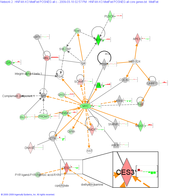Highlight
Challenge Project
Achievement/Results
The Challenge Project is a new feature of the Boston University Bioinformatics graduate program, introduced as part of our revised curriculum as proposed in the IGERT application. All first year students (not just IGERT students) participate. It consists of a two-semester project course (equivalent in credits to a regular one semester course) where students, in teams of 3 or 4, conduct bioinformatics oriented research on open-ended problems in biological networks using high throughput data obtained from one of our biology or medical school labs. The intent is to have the students explore the research experience under limited supervision so that they can generate ideas, carry them out, experience successes and failures, gain confidence in their own instincts, and learn what it’s really like to do original research.
Limited supervision was initially provided by the three faculty members donating the problems and data and by the PI who conducted weekly class sessions where the students discussed their progress. For 2008-2009, we had three teams and three faculty advisors: 1) Ulla Hansen (Biology) whose problem involves understanding the differential regulatory effects of estrogen on mouse cardiovascular tissue through the mediation of the two estrogen receptors/transcription factors ER alpha and ER beta, 2) David Waxman (Biology) whose problem involves understanding the molecular networks governing sex-dependent mouse liver gene expression in response to growth hormone, and 3) Avrum Spira (Pulmonary Medicine) whose problem involves understanding the interaction between messenger RNA and microRNA in mediating differential gene expression in airway epithelial cells in smokers versus non-smokers.
As the year progressed, team members focused on different aspects of the data and analysis techniques. In other words, they divided up the work so that each team member could follow his or her skill set and interests. And, they handed off the results of their analysis to each other, so that the project as a whole kept moving forward. It was very encouraging to see this in action. Additionally, the students reached out to other faculty for guidance and advice and this engendered (the hoped for) incipient collaborations among faculty from several departments who otherwise had had only limited interaction. A comment from one of the biology advisors is illustrative: “I didn’t know you could do that,” in response to an analysis technique developed independently by one of our math department faculty who was enlisted for guidance by the students. In total, the challenge project teams solicited advice from four additional faculty members and two postdocs. The faculty members are Marc Lenburg (Genetics and Genomics), Eric Kolaczyk (Math and Statistics), Paola Sebastiani (Biostatistics), and Simon Kasif (Biomedical Engineering).
While the analysis of the data was important and drove the projects, equally important was the learning experience for the students. It was particularly encouraging to see several students taking leadership scientifically. One student in particular, IGERT trainee Lisa Pham, learned a great deal from Math and Statistics professor Eric Kolaczyk about an analysis technique which separates, within a network, the effects of genes on each other from the effects of the experimental conditions. Lisa lead her team through complicated analysis of their data with this technique.
The work of the teams culminated in a set of computation based predictions, primarily about genes or interactions that may be important for the networks under study. The last month of the class involved working with the faculty supervisors to design experiments that could be used to validate the predictions. The final class meeting will take the form of a seminar presentation by each team in one of our weekly, program-wide Systems Biology Seminars in mid-May.
This was a difficult experience for the students, not least because they have many other demands on their time, including two or three rotations in labs over the two semesters. A large chunk of time was taken up by simple data conversion tasks that were more daunting than they seemed. My hope is that next year, the students from this year will act as advisors themselves for the new students, contributing their expertise and understanding of the pitfalls so that the students next year can move more efficiently through their projects.
Address Goals
This activity primarily addresses the goal of cultivating an outstanding scientific workforce. It emphasizes the goals of creativity, independence, and quality in student research and it creates opportunities for collaborative research among faculty from different disciplines. With respect to the secondary goal of advancing the frontier of knowledge, the work started by the students in the Challenge Project will be carried forward and ultimately advance our knowledge of the gene regulatory networks involved in three important cellular systems.






